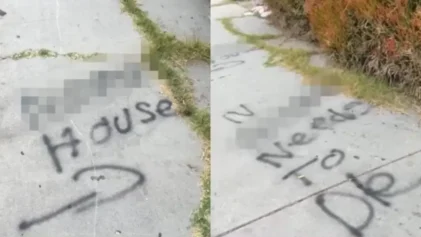
Texas High School teens shout ‘Heil Trump’ at graduation.
The New York Times reports five Loudoun County, Va., teens pled guilty to vandalizing Ashburn Colored School, “a dilapidated, one-room 19th-century schoolhouse that had been used by Black children during segregation.” Their sentence includes writing a research report on hate speech and reading books that detail the horrors of racism, like the autobiographies of Maya Angelou and Richard Wright, “I Know Why The Caged Bird Sings” and “Black Boy.” Virginia educators hope that, if anything can be salvaged from this crime, “it has to be through an effort to educate.”
White acts of racism are regularly attributed to cultural incompetence or a dearth of opportunities to hone racial sensitivity. But the barefaced anti-Black conduct repeatedly demonstrated by white children is impossible to minimize as juvenile naiveté.
Some of the most recent examples include the approximately 70 Texas high school students shouted “Heil Hitler” and “Heil Trump” during a school photo shoot. A white Texas cheerleader posted a Snapchat video where she chants and spells out the word “n—-r.” Pennsylvania’s Highlands School District was “shocked” and “stunned” that a white teen created a fake hunting license, where, CBS Pittsburgh reports, “the holder is permitted to hunt and kill black people.” This anti-black conduct is part of a larger historical record of threatening and dehumanizing Black people.
The celebration of violence against Black people illustrates a comprehensive understanding and application of white supremacist doctrine. Author and advocate to end the practice of racism Neely Fuller Jr. insists, “White people cannot be ignorant about racism.” For racism to endure, each generation must transfer racist ideas and the requisite knowledge to sustain it. Fuller speculates that “the average white person, about the time they’re 16, they know all the rules” needed to continue this practice.
“Two-Faced Racism”, co-authored by Joe Feagin and Leslie Picca, emphasizes the white family as the primary means of preserving white supremacy by ensuring white kids grasp how to practice racism. Feagin and Picca describe “one white woman whose mother had told her that, if children were not good, ‘n—-s would come in the night and steal us away.” These childhood events provide a lifelong foundation and justification for practicing racism and mistreating Black people.
The intergenerational exchange of racist culture is a ritual. University of Kentucky professor Melissa N. Stein documents how the lynching and castration of Black males provided a “teachable” moment for white youth: “Children of both sexes frequently collected twigs for the funeral pyre in which the terrified Black victim would be burned alive. Male children were initiated into the world of white supremacy through their observation of or participation in lynchings. And reluctant young participants were sometimes goaded by older male relatives into physically maiming or taunting the lynching victim.” These examples bring white youths early into an initiation into the duties and expectations of white identity.
Fuller and others rightfully underscore the role of parents, relatives and neighbors in molding how white children absorb and perform racism. But there is a plethora of supplementary material. Since all areas of people’s activity are contaminated by racism, white customs and expectations are constantly modeled for white children. Kristen Harrison and Nicole Martins conducted a study on the television viewing of young Black and white children. They found that watching television provided a self-esteem boost for young white boys. Martins explained irrespective of the show or the network, white male TV characters “tend to be in positions of power.” “Regardless of what show you’re watching … things in life are pretty good for you.” The good, white life projected to white children instills a since of entitlement to authority, an expectation of looking down on Black people. The study also found “with regard to Black boys, they are often criminalized in many programs, shown as hoodlums and buffoons,” which instills another generation of white youth with a hearty disdain for Black people.
Patrick Phillips’ “Blood at the Root,” which examines the 1912 purge of approximately 1,000 Black residents from Forsyth County, Ga., provides a chilling illustration of white youngsters being groomed by the “game” of plundering “Negroes.” Phillips depicts an expelled Black family “who’d received their ultimatum not from grown men but two white children.” They were subjected to such intense terrorism they accepted “a twenty-four notice [delivered by] two children aged five and six, respectively, who had learned the game from their elders.”
When asked to compare the conduct of these prepubescent Georgia whites to modern times, Phillips recalled an incident from his own childhood – also in Forsyth County. He and his family attended a January 1987 march in honor of Dr. Martin Luther King Jr.’s holiday, which was only in its second year as a federally recognized holiday. Hundreds of white Forsyth residents turned out to oppose the march; they hurled rocks, brandished firearms and nooses, and yelled racist insults. Phillips testified to seeing white teens and families in the armed, racist mob and described the spectacle as a continuum in the tradition of white children demonstrating their racial expertise.
It’s cliché – and perhaps logical – to rationalize childhood miscues as youthful innocence. But racist kids are the predictable, expected fruit from the tree of white supremacy. When asking white youth to research and write essays to better understand race, it’s best to remember their white parents and grandparents wrote the encyclopedia on racism.


